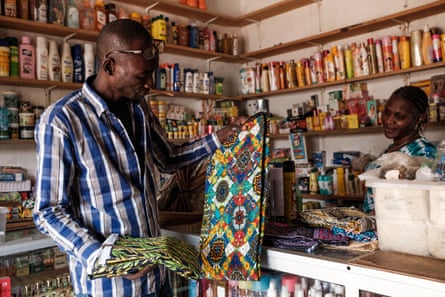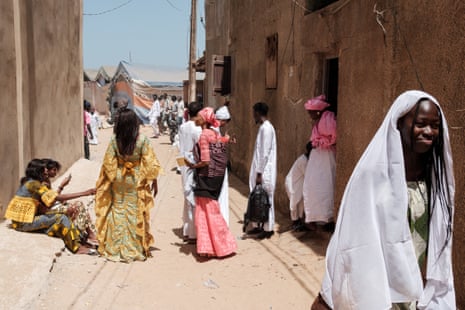Jackets are hung on one wall of Bada Seck’s single-room atelier in the Ngor arrondissement of Dakar in Senegal, dresses are arranged along another. Half-made garments lie on top of an unused sewing machine and bags of fabric cover the floor.
Seck’s workshop, in this former fishing village on the westernmost edge of the Senegalese capital might be modest, but his clients come from as far away as France.

“If there are the means, I make European styles with African fabrics,” he says, as he takes a brightly patterned suit jacket off the wall to look over. Festivals are a particularly busy time for him. “With Eid al-Adha and Eid al-Fitr there’s a lot of work – a lot, a lot. More than we can keep up with. Even if we work all night, till 5am. It’s tough, because everybody dresses up, and our work isn’t fast.”
Seck creates mostly made-to-measure fashion. Clients bring fabric bought on market stalls to tailors like him to turn into anything from kaftans, flowing boubous and dresses to western-style suits and bomber jackets.

Seck is one of many tailors who make up Senegal’s domestic fashion industry, which has helped attract big names to the country – Tommy Hilfiger and Levi’s recently opened stores in the capital. While Seck cuts and sews in his atelier along one of the village’s sandy alleyways, across the capital organisers anxiously prepared for the 20th Dakar fashion week in the first weekend of December. On Tuesday, Chanel hosted its Métiers d’Art show – which highlights the work of specialist artisans – for the first time in Africa.
Dakar fashion week’s founder, Adama Ndiaye – along with designers Karim Tassi from Morocco; the Nigerian brand Emmy Kasbit; and Mimi Plange from Ghana – showed their collections along runways on the island of Gorée. Despite being “charged with such a sad history”, Gorée, once a hub for the international slave trade, is a place where a “cultural mix” can be seen, Ndiaye said at a press conference.

“Senegal – and Dakar in particular – it’s a country with a strong cultural presence,” says Roméo Moukagny, a Gabonese designer working in Dakar’s Liberté 6 neighbourhood. “Even in something modern, there’s a traditional touch that stays there. Every 10 metres you have an atelier. Even if you’re a foreigner, you have your chance like everybody … If you want to apply for a competition, you don’t have to be a [Senegalese] national. You can apply. You can open a business. There is really an accessibility.”

Busy in Moukagny’s workshop is Aton Tsiba, a fashion designer from the Republic of the Congo who presented his collection at a fashion week show for up-and-coming designers.
“My [collection] celebrates everybody who has contributed to the advancement of culture,” says Tsiba, as a tailor in the next room makes final touches to the outfits about to be modelled.

“There’s more accessibility [in Dakar],” he says. “The material, the fabrics are more accessible. There’s also the diversity that you can see in the number of designers. It’s a bit more advanced in terms of fashion. It’s an environment that suits me.”
The Senegalese designer Selly Raby Kane, who presented a capsule collection showcasing her looks from the past decade, says Senegalese – and west African – style is a force to be reckoned with.
“Senegal has a very, very serious culture of fashion, textiles, embroidery – hand embroidery – savoir faire. It’s precious for us,” she says. “Nigeria has a strong fashion scene as well … Senegal is having a bit of an imprint [from] Lagos in terms of traditional attire, mainly. So there is a dialogue that is happening in west Africa.”

Indeed, every day is a fashion show in Dakar. Anseme René Carvalho sips tea at a lunch stand across the street from a mosque as worshippers shuffle inside. He’s wearing a mustard-yellow kaftan nearly reaching his feet. But he isn’t there to pray. “I’m not Muslim,” says Carvalho, part of the country’s tiny Christian minority. But “on Fridays, we dress like this. It’s the traditional dress.”
Most of Senegal’s domestic fashion industry exists independently of designer shops or events such as Dakar fashion week. “I create with my head,” says Seck, who says he hadn’t heard of fashion week. Tickets for shows cost about 50,000 CFA (£65), outside most budgets in a country where GDP per capita is about £1,300.

The Ngor market stallholder Mamadieng Diallo says he goes to his tailor every three months for a new outfit.
“If I see some material and it’s nice to me, I buy it and take it to the tailor,” he says. “Even if it’s not [Eid], in three months I’ll buy something – sometimes two months.”
Mame Diary Diouf, who runs an atelier down the street from Moukagny’s workshop, says Dakar has a rich environment for tailoring.

“We have all types of clients. Every month, we try to create new designs to propose to our clients. At the same time, clients can bring fabric directly,” she says.
“The embroidery is made by hand. It’s our style. It’s tradi-modern,” Diouf adds. “Our style can be worn by everybody.”

